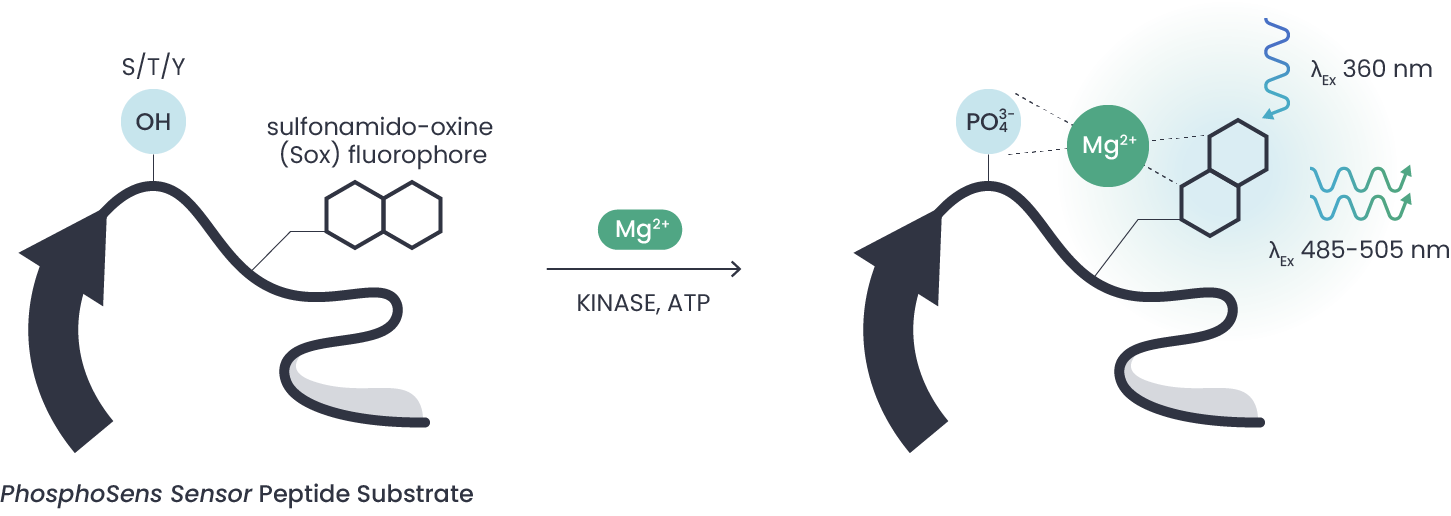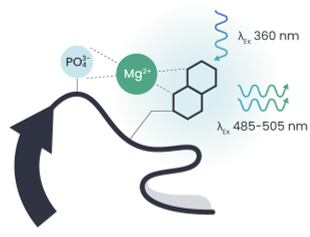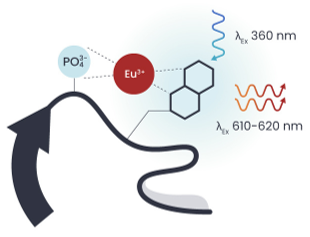One Fluorescence Platform for Protein Kinases and Phosphatases — in Recombinant and Lysate Samples
PhosphoSens® technology is a universal fluorescence detection platform for quantifying enzyme activity directly at the substrate level — whether studying protein kinases or protein phosphatases, in purified recombinant enzymes or complex cell or tissue lysates.
At its core are patented sensor peptide substrates that fluoresce upon phosphorylation or dephosphorylation, enabling either continuous or single-timepoint measurement of catalytic activity without coupled enzymes, antibodies, or wash steps.
AssayQuant’s PhosphoSens platform powers two complementary formats:
-
PhosphoSens-Kinetic Activity Assays — continuous, real-time measurement for mechanistic and kinetic analysis.
-
PhosphoSens-Red Screening Assays — single-read, time-resolved fluorescence (TRF) format for high-throughput screening.
Together, these formats provide unmatched flexibility across enzyme classes and sample types — one chemistry, two workflows, all data directly tied to catalytic function.
Direct Enzyme Activity Detection Powered by Technology-Packed Sensor Peptide Substrates
Most phosphorylation assays rely on indirect detection or secondary reagents.
PhosphoSens® directly detects enzymatic turnover in real time by linking phosphorylation events to a change in fluorescence intensity — producing a quantitative signal that reflects product formation as it happens.
The platform’s innovation lies in a library of >50,000 optimized peptide substrates containing the Sulfonamido-oxine (Sox) fluorophore positioned near the phosphorylation site. When phosphorylated, local charge changes enhance magnesium (Mg²⁺) coordination, increasing fluorescence intensity in proportion to the enzymatic turnover rate.
Fluorescent Sensor Peptide Substrates:
Each PhosphoSens® substrate is designed for a specific enzyme and assay format:
-
Sensor Peptide Sequence
Target-optimized peptides derived from physiologically relevant phosphorylation motifs.
Covalently attached Sox fluorophore positioned ±2–5 residues from the serine, threonine, or tyrosine phosphorylation site. -
Sox Fluorophore
The Sox group exhibits Mg²⁺-dependent fluorescence that increases upon phosphorylation, providing a direct, real-time readout of catalytic activity. -
Chelation-Enhanced Fluorescence (CHEF)
Upon phosphorylation, Mg²⁺ binding strengthens, producing a fluorescence enhancement proportional to phosphorylated product concentration.

Applicable Enzyme Classes & Sample Types
PhosphoSens® assays are validated across the two major enzyme classes that regulate phosphorylation—protein kinases and protein phosphatases—and are fully compatible with both recombinant and lysate sample types.
This flexibility allows you to measure enzymatic activity under precisely defined conditions or in native biological contexts that preserve physiological regulation.
Enzyme Classes:
Sample Types:
Protein Kinases
Measure phosphorylation directly at the substrate level to assess enzyme activity, compound selectivity, and inhibitor potency.
PhosphoSens® kinase assays provide true kinetic or single-read data that accurately reflect catalytic turnover and mechanistic behavior under physiologic ATP and cofactor conditions.
Purified Enzymes
Gain deep mechanistic insights using recombinant kinase or phosphatase enzymes under defined buffer, ATP, and cofactor conditions.
Ideal for enzyme kinetics, compound potency determination, and mechanistic characterization where reaction control is critical.
Protein Phosphatases
Quantify dephosphorylation activity in real time to evaluate reversibility, regulatory control, and inhibitor effects.
PhosphoSens® phosphatase assays operate under physiologically relevant Mg²⁺ or Mn²⁺ concentrations, enabling precise measurement of enzymatic activity and pathway modulation.
Cell Lysates & Tissue Homogenates
Directly measure endogenous kinase or phosphatase activity in biologically relevant and complex matrices.
Capture pathway-level activity, inhibitor effects, and regulatory responses in native cellular environments to link biochemical behavior with biological relevance.
Simple Workflow for Continuous and Screening Formats
All PhosphoSens assays share the same homogeneous, mix-and-read workflow — only the detection mode differs.
Step 1: Start the Reaction
Combine enzyme, PhosphoSens Sensor Peptide Substrate, ATP, and buffer in a microplate.
Reactions proceed homogeneously — no coupling, no wash steps.
PhosphoSens-Kinetic Activity Assays
Track enzyme activity as it happens. Fluorescence intensity (λ ≈ 485/505 nm) increases continuously as substrate is phosphorylated or dephosphorylated.
The resulting progress curves reveal true catalytic rates and mechanistic behaviors such as time-dependent inhibition, partial reversibility, and slow-binding kinetics.
Ideal for mechanistic assays, time-dependent inhibition (TDI), and kinetic modeling.

PhosphoSens-Red Screening Assays
For high-throughput screening, the PhosphoSens-Red format uses Europium (Eu³⁺) as a stop reagent and TRF readout (λ ≈ 360 nm → 610–620 nm).
This single-timepoint approach maintains direct substrate detection while eliminating background autofluorescence.
Optimized for high-throughput screening, using a Europium-based TRF readout to eliminate autofluorescence.

Advantages
Direct
No coupling, secondary enzymes or antibodies. Activity is measured directly from the substrate level.
Continuous
Kinetic progress curves in real time — no assumptions, no extrapolation. Greater accuracy and mechanistic insight.
Physiologically Relevant
Substrates derived from biological sequences and assays run under physiological conditions.
Streamlined Workflow
Add & read—no washes, immobilization, or custom equipment needed. Ideal for HTS and automation.
From Screening to Kinetics — One Platform, Unified Chemistry
Use PhosphoSens-Red Screening Assays to identify active compounds or probe selectivity, then transition seamlessly to PhosphoSens-Kinetic Activity Assays for quantitative mechanistic insight.
Both leverage the same trusted chemistry — providing continuity from discovery to detailed characterization.
Identify and Validate the Right Candidates Faster with Richer Data
Applications:
- Kinome Profiling: Gain detailed kinetic insights into compound selectivity and mechanisms of action (MOA) by profiling against a comprehensive panel of over 400 wild-type kinases. Experiments can be conducted under physiological conditions with high or low ATP levels to match your research needs.
- IC₅₀ or Kᵢ Determination: Evaluate compound potency using 12-point dose-response curves. Flexible assay conditions include the presence of BSA or DTT, high or low ATP levels, and the ability to analyze protein complexes or crude lysates.
- kinact/Kᵢ for Time-Dependent Inhibition: Quantify covalent compound inhibition dynamics with 24-point time-dependent assays. These provide precise measurements of inactivation rates (kinact) and covalent binding affinities (Kᵢ).
- Residence Time: Characterize compound binding kinetics using the Jump Dilution method, with a detection range from 30 seconds to 48 hours. This service provides valuable data on compound dissociation rates for informed drug discovery.
- Mechanism of Action (MOA): Uncover how your compound interacts with kinases through detailed studies using ATP, peptide, or lipid substrates. Tailored to your target and research goals, MOA assays provide actionable insights.
- EC50: Assess compound potency for target activation with EC₅₀ measurements, delivering reliable data on dose-dependent activation to guide lead optimization.
Indications:
- Cancer: Exploring kinase-driven pathways, such as those involved in uncontrolled cell proliferation and survival, and metastasis.
- Neurological Disorders: Investigating signaling pathways regulated by kinases or phosphatases including Parkinson’s Disease, stroke, and various tauopathies such as Alzheimer's disease (AD), frontotemporal dementia, corticobasal degeneration (CBD), and chronic traumatic encephalopathy, characterized pathologically by the deposition in the brain of aggregates of the insoluble hyperphosphorylated form of the tau protein (p-tau).
- Cardiovascular Diseases: Studying kinases or phosphatases that affect heart function, blood vessel regulation, cardiac hypertrophy, myocardial infarction and hypertension.
- Immunology: Evaluating kinases or phosphatases involved in immune cell activation, chronic inflammation, and autoimmune diseases where signaling is deregulated.
- Metabolic Disorders: Characterize kinases or phosphatases implicated in diabetes, insulin resistance, obesity, dyslipidemia, and metabolic dysfunction-associated fatty liver disease (MAFLD).
The Best Solutions Start with a Conversation
Not sure which product or service is the best fit for your project? At AssayQuant, our team of scientific experts can provide the guidance and support you need to achieve your research goals.
Stay Informed
Want to hear the latest about our technology? Be among the first to learn about our latest products and services.